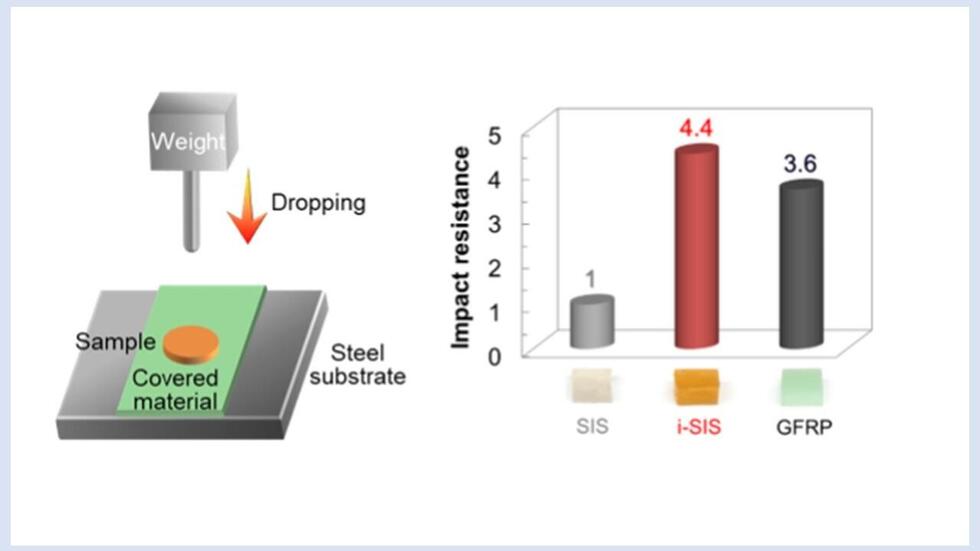
Chemistry
December 21, 2021
New rubber material's impact resistance surpasses that of glass-fiber reinforced plastic
Nagoya University and the Zeon Corporation have developed a new thermoplastic rubber material, based on a type of ionically-functionalized block polymer called "i-SIS", with a high impact resistance - higher than glass-fiber-reinforced plastic.
Thermoplastic elastomers (TPEs - sometimes called thermoplastic rubbers) are a chemically-bonded combination of multiple polymers ("copolymer") - typically a plastic and a rubber - that have both thermoplastic and elastomeric properties. The thermoplastic property is useful in injection molding, while the elastomeric property gives the object the ability to stretch and return to nearly its original shape. These materials are ubiquitous, for example, in the interiors and exteriors of vehicles. The best-known TPEs include "styrenic block polymers", which contain molecular blocks of polystyrene, which is hard, and polydiene, which is rubbery. Two important examples are polystyrene-b-polyisoprene-b-polystyrene (SIS) and polystyrene-b-polybutadiene-b- polystyrene (SBS). Styrenic block polymers were developed by the Shell Chemical Company in the 1960s and have since been further developed by many researchers in both academia and industry. While the annual global market for styrenic block polymer-based TPEs is worth several billion dollars, elastomers with enhanced mechanical properties, especially toughness, also remain in great demand.
To improve the mechanical properties of styrenic block polymers, Nagoya University and the Zeon Corporation recently reported industry-friendly synthesis of chemically modified SIS such as hydrogen-bonded SIS (h-SIS) and "ionically functionalized SIS" (i-SIS) - which is SIS with positive ions such as sodium bonded in it. The "cation" has one (monovalent) electron removed from the outer shell. (See https://doi.org/10.1016/j.polymer.2021.123419.) Preliminary measurements showed that i-SIS has an extremely high tensile toughness of 480 MJ/m3, which is the highest value of any known thermoplastic rubber material as far as we know.
Although a preliminary tensile test is useful for investigating the common mechanical properties of materials, it does not reveal all of the mechanical features of the materials, particularly impact resistance that is crucially important in practical applications. Moreover, measuring the impact resistance is also important for understanding the mechanism by which desirable mechanical properties arise in the material, and therefore how they can be achieved.
This study by Nagoya University and the Zeon Corporation is the first to evaluate the impact resistance of the new elastomeric materials based on i-SIS, and compare them to the impact resistance of a typical high-strength material based on glass-fiber-reinforced plastic (GFRP), which has a tensile strength of 330 MPa. Drop weight impact tests demonstrated that i-SIS with monovalent or divalent cations is 3 or 4 times more impact resistant than chemically-unmodified SIS; moreover, i-SIS with divalent cations is found to be 1.2 times more impact resistant than typical high-strength GFRP. In total, i-SIS, especially with divalent ions, was found to be highly impact resistant, even though inorganic fillers - a typical additive for hardening polymers - are not incorporated into the polymer and the molecular structure of the polymer is not chemically cross-linked.
Fig. 3. Photographs of SIS, i-SIS and GFRP, and impact resistance
of each sample compared to that of SIS (Credit: Atsushi Noro)
Automobile and other vehicle manufacturers are continually searching for lighter materials that are also resistant to damage. Since i-SIS can be synthesized on an industrial scale, it has a great potential to become a next-generation elastomeric material for use not only in interior and exterior automobile parts, but also for automobile bodies, and even the outer panels of automobiles, trains, and other vehicles that require structural materials with high impact resistance as well as ease of manufacture. These research achievements will also contribute to the development of lightweight vehicles and the establishment of a carbon-free society.
The paper, "Highly Impact-Resistant Block Polymer-Based Thermoplastic Elastomers with an Ionically Functionalized Rubber Phase" was published in ACS Omega on December 20, 2021, at https://doi.org/10.1021/acsomega.1c05609 (OPEN ACCESS).
Authors: Takato Kajita1, Atsushi Noro1,2*, Ryoji Oda3, and Sadaharu Hashimoto3
1 Department of Molecular & Macromolecular Chemistry, Graduate School of Engineering, Nagoya University
2 Institute of Materials Innovation, Institutes of Innovation for Future Society, Nagoya University
3 Zeon Corporation, 1-6-2 Marunouchi, Chiyoda-ku, Tokyo 100-8246, Japan
An image associated with this study has been selected to appear on the front cover of the journal issue in which this paper will appear. (Use the above link to the paper.)
Expert Contact:
Atsushi Noro
Graduate School of Engineering and Institutes of Innovation for Future Society
noro@nagoya-u.jp